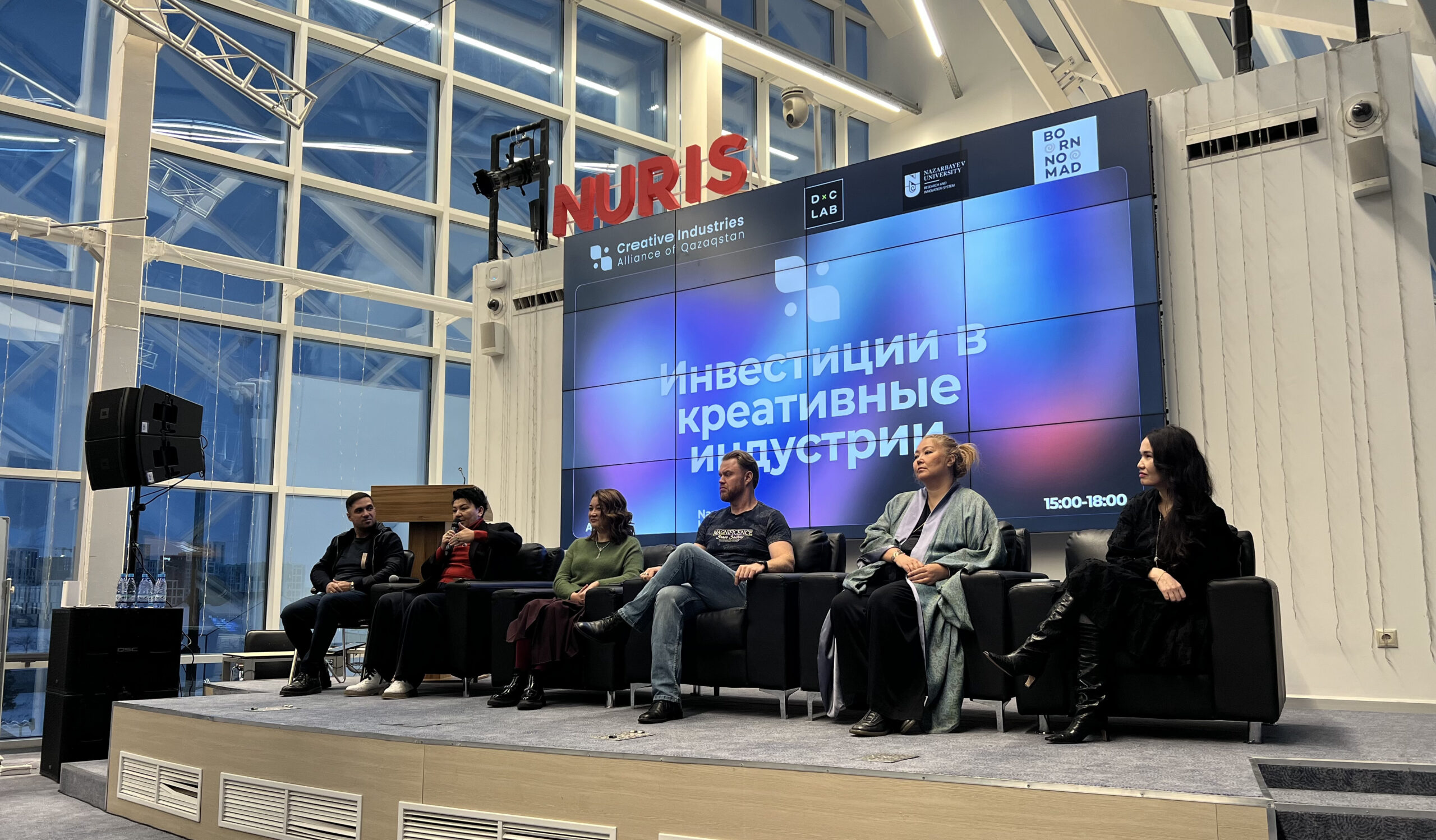ASTANA—Creative Industries Alliance Qazaqstan (CIAQ) and Nazarbayev University Research and Innovation System (NURIS) hosted a panel discussion on Dec. 11 in Astana. The discussions focused on investment opportunities in Kazakhstan’s creative sector. Entrepreneurs, investors, and policymakers addressed pressing issues and explored solutions to boost the industry’s growth.

A panel discussion hosted by CIAQ and NURIS on Dec. 11 in Astana. Photo credit: Nagima Abuova / The Astana Times
Creative industries represent a dynamically growing segment of the economy, distinct from traditional sectors such as mining, manufacturing and agriculture. In these industries, value is generated through intellectual property, ideas and concepts. However, the business model is relatively new for Kazakhstan and often requires clarification for investors, authorities and development institutions.

Aika Alemi, the CIAQ chair and the investment initiative lead. Photo credit: Zhanserik Askar
Creative industries in Kazakhstan face significant challenges, including a lack of investment and limited access to capital.
“To attract investment in creative industries, CIAQ holds regular meetings where we share successful case studies, demonstrate the profitability of sectors like cinema, music, media and design, and outline the support needed from the state. Meanwhile, investors discuss criteria, risks, and investment requirements for projects and startups,” said Aika Alemi, the CIAQ chair and the investment initiative lead, highlighting the efforts to address these challenges.
Global growth, local potential and challenges
At the event opening, David Tuganov, the CIAQ’s co-founder, presented an overview of the creative industries and CIAQ’s role. He highlighted the global expansion of creative industries and described them as the fastest-growing economy.
“Kazakhstan adopted the concept of developing creative industries in 2021. Three years later, we are here to catalyze this blue ocean opportunity. The economic contribution of creative industries in Kazakhstan is 2.7% of GDP compared to 14% in the UK and 10% in Germany, according to Deloitte data. While these numbers show we have a long way to go, they also indicate immense potential,” said Tuganov.

David Tuganov, CIAQ’s co-founder, presents an overview of the creative industries and CIAQ’s role. Photo credit: Nagima Abuova / The Astana Times
He noted that it is essential to build a supportive environment in Kazakhstan. “Creators always go where the market and infrastructure exist,” he said.
Tuganov also proposed tax reforms and identified five key areas for government support: event management, curatorial activities, creative clusters, research in creative economics and informal education such as extracurricular clubs and academies.
“We aim to build a support network, promote exports and engage stakeholders through events and forums to highlight the importance of investing in creativity,” added Tuganov.
Why are creative industries underfunded, and what are the solutions
During the panel session, creators and industry experts shared personal experiences and opinions on attracting investors to local projects and monetizing the industry.
“Creative industries in Kazakhstan and Central Asia are still underfinanced and lack investment and access to capital, and that hinders their development. The reason is that, on the one hand, creative entrepreneurs need to up their market and investor readiness capacity. On the other hand, the investors are not ready for high uncertainty business model, are not familiar with social impact investment instruments and do not always understand how value is created in film, music, media, fashion, design and theater,” said Alemi.

Indira Makhmetova, founder of Archicad, highlights the need for education among creators to better plan and assess their projects’ investment potential. Photo credit: Nagima Abuova / The Astana Times
Indira Makhmetova, the founder of Archicad, a communication platform organizer for architects, designers and developers, highlighted the need for education among creators to better plan and assess their projects’ investment potential. She noted that to support creative industries, it is necessary to determine priorities such as tax incentives for content creators and develop a clear typology of creative hubs.
“A real creative hub is a space where representatives of creative industries interact and create new products. However, even in neighboring countries, some projects positioned as creative hubs are just spaces for renting offices or coworking spaces,” said Makhmetova.
Makhmetova suggested that Kazakhstan could consider the old Soviet practice when floors of buildings were allocated for galleries and workshops free of charge, turning such spaces into centers of public art and creative interaction.
Artyom Slesarenko, the CEO of Rhinotales game development studio, echoed similar sentiments, discussing the entrepreneurial gaps among creators. “We lack the skills to ‘package’ projects for investors. Most investors prefer low-risk options, leaving creative industries’ potential unclear,” he said.
According to Slesarenko, creators should focus on global markets and create scalable products to attract venture capital.
“For example, if we are creating a gaming studio, its value is typically assessed using a multiplier of six times the revenue. This means that if we target a revenue of $20 million, the estimated value of the studio would be around $100 million, which is already becoming an understandable and interesting offer for venture investors. We need to work in this direction, build global products and speak to investors in their language. This is the only way to make creative industries truly competitive,” said Slesarenko.
Investments with social value
Zhanar Zhakanova, the CEO of Arujan Production creative agency, addressed the lack of investment in children’s and family content in Kazakhstan. Zhakanova’s BalaMedia initiative on YouTube produces educational videos on security, financial literacy, ecology, business and creative thinking.

Zhanar Zhakanova, CEO of Arujan Production creative agency, addresses the lack of investment in children’s and family content in Kazakhstan. Photo credit: Nagima Abuova / The Astana Times
“According to our research with journalists, over the past five years, only a small fraction of 20 billion tenge (US$38 million) allocated for cinema has been spent on children’s films,” said Zhakanova, noting that this leads to a cultural gap where children consume foreign content instead of materials reflecting Kazakh traditions and values.
Zhakanova added that there is also a growing interest in social entrepreneurship. Thus, Kazakhstan has created benefits for those engaged in cultural and educational activities.
“These are access to cheap loans at 7%, grants up to five million tenge (US$9,500) and the possibility of obtaining premises on preferential terms. However, creating high-quality family content requires greater investor involvement. We see the potential in impact investments, which not only bring profit but also create social value,” said Zhakanova.
Gaps, opportunities for export and collaboration
Vladimir Barinov, the CEO of Vardix Group, a group of companies offering services in creating interactive applications, films and videos based on 3D graphics, emphasized the significant potential for developing Kazakhstan’s creative industry, noting that the country already has resources—money, talent, and artistic vision—but lacks the structural cohesion to advance the sector.

Vladimir Barinov, CEO of Vardix Group, emphasizes the significant potential for developing Kazakhstan’s creative industry. Photo credit: Nagima Abuova / The Astana Times
“Creatives here often wait for someone to come and fund their ideas, while investors are waiting for finished products. There is a gap. In the creative industry, we need a clear system that translates artistic outputs into marketable business tools. Investors do not care whether they are funding art objects or dumpling production—they need clear terms,” said Barinov.
To address this issue, Varinov suggests that the market needs strong and experienced producers. These people can explain to investors how to support creative ventures, organize the work, and turn it into well-funded and scalable business products. Additionally, he highlighted that Kazakhstan’s creative projects must aim beyond the domestic market to succeed.
“The local market is small, and no one will invest heavily in projects limited to it. But if we scale our ideas globally, the potential is enormous. This requires finding talent, nurturing it, and creating systems for sustained support, like investor clubs or collaborative networks,” said Barinov.
“Kazakhstan is an amazing place for creative potential, but to thrive, we must think internationally and act as a unified, business-savvy industry,” he added.
The event also included a panel discussion from investors’ perspectives, where the speakers explored several issues, including why there is still a lack of active investment in creative industries, what criteria and investment volumes are being considered, and what risks are perceived in the sector. The panel featured investors, representatives from international and local development institutions, and state and municipal authorities.

Panelists, featured by venture investors and development institutions discuss investment potential in Kazakhstan’s creative industries. Photo credit: Zhanserik Askar
“Creative industries hold significant potential in Kazakhstan, which is driven by the abundance of creative and talented young people in the country. However, one critical element is missing: sufficient financial support and effective mechanisms to stimulate and develop the sector. Addressing these gaps is essential, and it is hoped that both the government and the private sector will work collaboratively to achieve these goals. With the proper measures, the creative industry could become a key export-oriented sector for Kazakhstan,” said Ruslan Rakymbai, CEO of Quest Ventures Central Asia, the regional branch of the Singapore-based venture capital firm.


